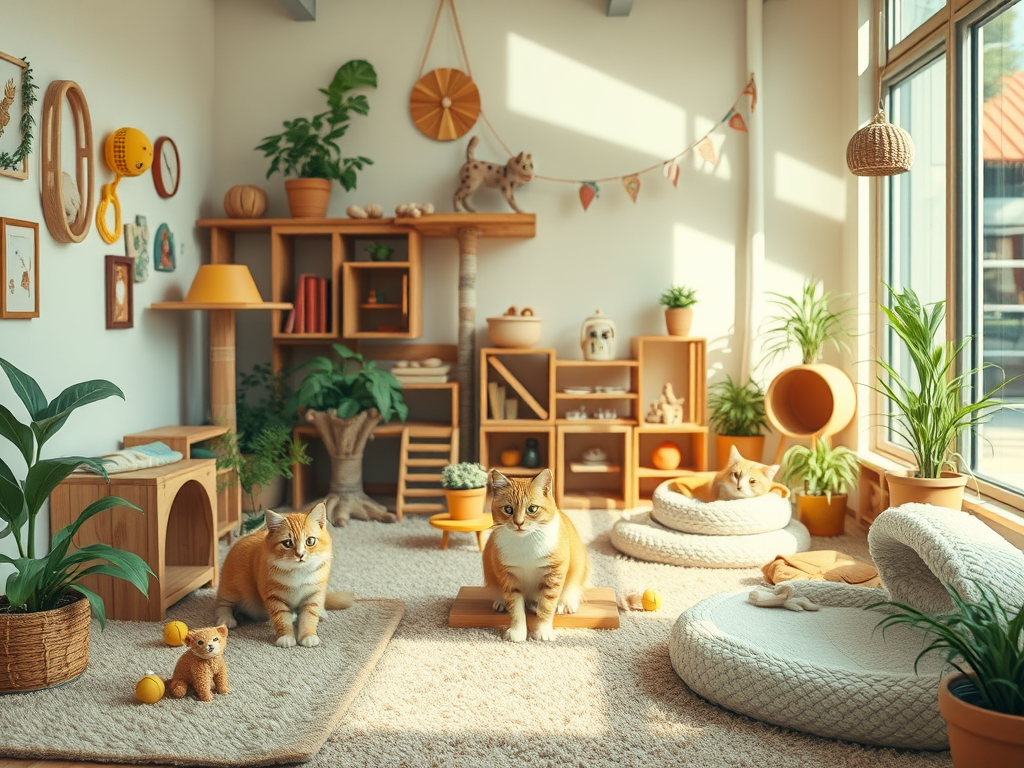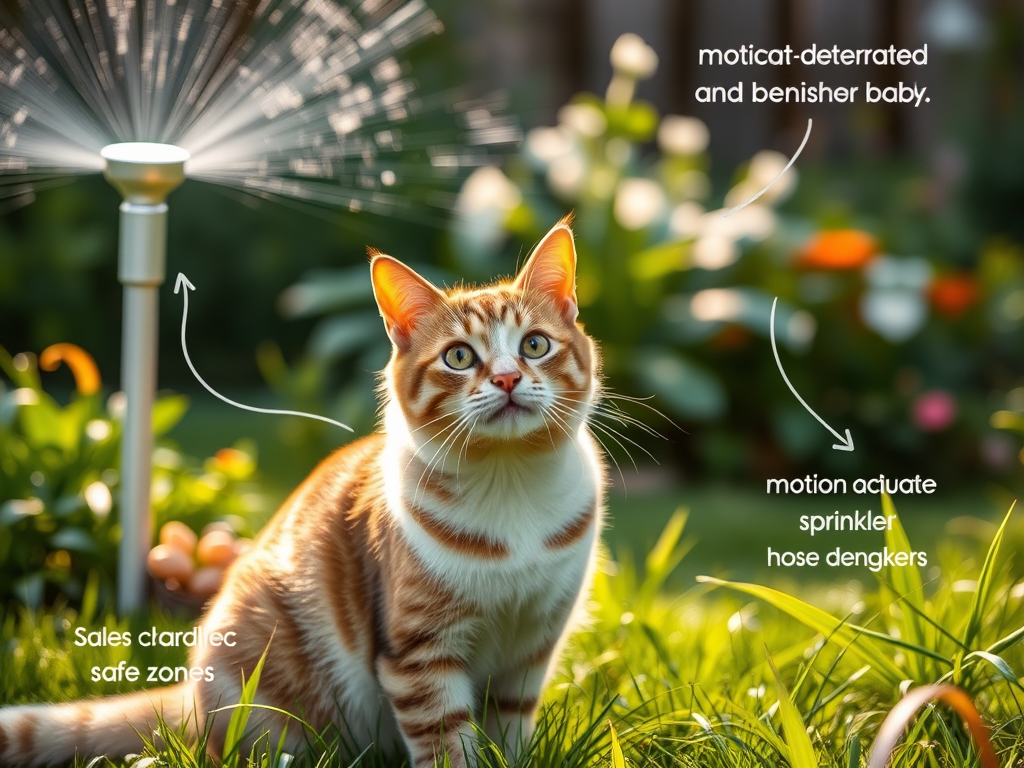Effective Strategies for Reducing Your Cat’s Hunting Behavior
Reducing Your Cat’s Hunting Impact: Cats have an inherent hunting instinct, a trait that is deeply ingrained in their evolutionary history. To foster a safe and enriching indoor environment, it’s essential to nurture these instincts while simultaneously protecting local wildlife. By creating engaging spaces filled with stimulating activities and sensory experiences, you can keep your cat entertained and mentally satisfied, all while ensuring that they do not pose a danger to birds and small animals outside your home.
Incorporating interactive toys into your cat’s daily routine can greatly enhance their indoor hunting experience. Toys like feather wands, laser pointers, and battery-operated mice can captivate your cat for hours on end. These engaging toys simulate natural hunting behaviors, allowing your feline to practice tracking and pouncing, which not only provides essential physical exercise but also crucial mental stimulation. By keeping your cat entertained with these challenges, you foster their well-being while helping them channel their energy positively.
Transform your living space into an enticing feline playground by constructing obstacle courses that feature an array of boxes, tunnels, and climbing shelves. This DIY jungle gym promotes physical activity and exploration, allowing your cat to jump, climb, and investigate various nooks and crannies. Cats are naturally curious, and by providing them with a diverse range of environments to explore, you can mimic the thrill of a wild adventure in the safety of your home.
Don’t overlook the benefits of puzzle feeders. These innovative feeding devices not only challenge your cat mentally but also mimic the effort they would exert while hunting. By incorporating treat-dispensing puzzles into your cat’s meal routine, you can keep their minds sharp and engaged while providing a fun and rewarding experience. This method not only entertains your pet but also encourages healthier eating habits, as they learn to ‘hunt’ for their food.
Prioritizing playtime is essential for maintaining a happy and healthy cat. Engaging in social interaction through play is critical for strengthening the bond between you and your feline companion. Make it a point to schedule regular play sessions, using the same toys that they enjoy during their solo activities. This shared engagement not only alleviates any pent-up energy your cat may have but also enhances your relationship, making playtime a rewarding experience for both of you.
Creating a stimulating indoor environment for your cat is entirely achievable with a touch of creativity and commitment. Your home can be more than just a shelter; it can become an adventurous landscape that satisfies their natural hunting instincts while keeping them safe from outdoor dangers. With thoughtful planning and execution, you can ensure your indoor cat leads a happy and fulfilled life.

Unlock Exciting New Adventures for Your Cat Through Leash Training
Embracing leash training can open up a whole new world of safe outdoor exploration for your cat. Although walks are typically associated with dogs, cats can also enjoy the benefits of outdoor adventures when introduced to proper training techniques and sufficient patience. By familiarizing your feline friend with a harness and leash, you can allow them to experience the wonders of nature while ensuring their safety.
Begin your leash training journey with a well-fitting harness that your cat finds comfortable. It’s vital to let your pet familiarize themselves with the harness before attempting to put it on. Allow them to sniff and inspect the harness, which will help alleviate any anxiety they might feel. Gradually introducing the harness at their pace fosters positive associations and makes the transition smoother for your furry friend.
Once your cat is accustomed to the harness, attach a lightweight leash and practice walking indoors. This controlled environment will help them adjust to the sensation of wearing a leash while building their confidence. Take your time, and be prepared for some initial resistance; patience is crucial in helping your cat acclimate to this new experience.
When you’re ready to venture outside for the first time, select a calm and secure area, such as your backyard or a quiet park. Make sure that the location is free of heavy traffic and distractions to help your cat feel secure. Start with brief outdoor sessions to avoid overwhelming your pet, gradually extending the duration as they become more comfortable with exploring their new environment.
Supervised outdoor time enriches your cat’s life, allowing them to enjoy the sights, sounds, and scents of nature without endangering local wildlife. Imagine the joy on your cat’s face as they encounter new experiences in a safe setting. This bonding time not only enhances their quality of life but also strengthens your relationship.
Real stories from fellow cat owners can serve as motivation. Many have expressed their initial doubts about whether their cats would adapt to leash walking, but with consistency and positive reinforcement, they have seen remarkable successes. Celebrate each small victory as a step toward broadening your cat’s horizons while ensuring their safety.
By incorporating leash training into your cat’s routine, you’re facilitating an enriching blend of outdoor enjoyment and wildlife protection. This balanced approach allows your cat to explore while fostering a sense of security in their environment.
Create Safe Outdoor Experiences for Your Cat with Catios
Outdoor cat enclosures, commonly known as catios, offer the perfect solution for adventurous cats seeking outdoor experiences without the inherent risks. These secure structures allow your feline companions to relish the joys of the outdoors while ensuring both their safety and the protection of local wildlife.
When considering a catio, you can either build or purchase one tailored to your available space and budget. Options range from simple balcony enclosures to more elaborate constructions in your backyard. The primary focus should always be on making sure the structure is escape-proof, as ensuring your cat’s safety is paramount in providing a secure environment.
While designing your catio, think about incorporating multiple levels and cozy hideaways. Cats thrive in environments that offer vertical spaces and places to retreat. By including platforms, ramps, and hammocks, you can transform a basic enclosure into a stimulating paradise that closely mimics their natural habitat.
To enhance the sensory experience within the catio, introduce elements like cat grass, scratching posts, and logs, creating a stimulating environment filled with various textures and scents. This sensory enrichment can keep your cat engaged and content while allowing them to experience the joy of being outdoors in a controlled setting.
Regular maintenance is vital for ensuring the safety of your catio. Routinely inspect for any signs of wear and tear, including the integrity of the mesh, the structure, and the locks. Cats are naturally curious and may test the boundaries of their enclosure, so keeping it in good condition is vital for their safety and well-being.
With a catio, your feline friend can enjoy sunbathing, climbing, and observing wildlife without posing a threat to local ecosystems. They can bask in the sun and watch birds from the safety of their outdoor haven, remaining content while wildlife is protected.

Proven Behavioral Training Techniques to Curb Your Cat’s Hunting Instincts
Training your cat to minimize their hunting behaviors might seem daunting, but with the right techniques, it can become a manageable task. The first step involves understanding their natural instincts and the behaviors that drive them to hunt, which is crucial for implementing effective training strategies.
Utilizing technology can significantly enhance your training efforts. Consider employing motion-activated deterrents, such as sprinklers or noise-makers, to establish boundaries that discourage hunting without disrupting your yard’s overall ambiance. Strategically zoning your outdoor space can redirect your cat’s attention away from potential prey, effectively guiding their instincts.
Positive reinforcement plays a pivotal role in modifying your cat’s behavior. Reward them for non-hunting actions with treats or affection. For instance, if your cat responds to their name or refrains from pursuing a potential target, offer them a tasty treat or some extra love. This method encourages them to repeat desirable behaviors while diminishing their instinctive urge to hunt.
Incorporating clicker training can also be a powerful tool in your training arsenal. This technique allows you to associate a distinct sound with positive actions, fostering a connection between their behavior and rewards. By clicking when they display desirable behavior, you can reinforce good habits and clarify expectations for your cat.
For more tailored support, consider consulting with feline behavior specialists. They can provide personalized advice and insights that address specific challenges, ensuring you and your cat coexist harmoniously while respecting the local wildlife.
The aim of these deterrents and training techniques isn’t to punish but to guide your cat toward behaviors that prioritize their safety and the environment. With consistency and patience, you can redirect their instincts, leading to safer outdoor interactions for both your cat and local wildlife.
Strategically Feeding Your Cat to Alleviate Hunting Drives
The type of food you provide and your adopted feeding methods can have a significant impact on your cat’s hunting instincts. Interestingly, a well-fed cat can still display hunting behaviors, but how you feed them can help mitigate this drive.
Free feeding, where food is available throughout the day, may not be suitable for every cat. Instead, consider setting a schedule for feeding times. By establishing predictable mealtimes, your cat may become less inclined to hunt, as they learn to associate food with specific times of the day, minimizing their need to seek out prey.
Implementing interactive feeding strategies can be transformative for your cat’s behavior. Using food puzzles or dispensers can replicate the act of hunting, requiring your cat to ‘work’ for their meals. This not only keeps them mentally and physically stimulated but also channels their energy in a positive direction, allowing their natural instincts to be expressed safely.
It’s also crucial to pay attention to the nutritional content of their food. A diet rich in protein and low in carbohydrates aligns better with a cat’s natural dietary needs, potentially resulting in a decrease in hunting behaviors. Collaborating with a veterinarian to tailor their diet will ensure your cat’s nutritional requirements are effectively met.
Offering a variety of food types can also satisfy their inherent curiosity and appetite for novelty. Alternating between dry kibble, wet food, and raw diets can keep mealtime exciting, reducing the temptation to seek thrills outside their food dish.
Feeding strategies extend beyond mere sustenance; they are a powerful tool for managing your cat’s behavior. By adjusting how and what you feed them, you can effectively lessen their inclination to hunt while keeping them satisfied and healthy.

Fostering Community Responsibility for Cat Conservation
Cats make delightful companions, and as their guardians, we have a responsibility to ensure they coexist harmoniously with local wildlife. By embracing community efforts and personal accountability, we can significantly diminish the ecological impact of free-roaming cats.
Engaging with local conservation groups is a fantastic way to stay informed about wildlife-friendly practices. Many communities offer educational workshops for cat owners, addressing the ecological consequences of allowing cats to roam freely and providing solutions to mitigate these effects.
Consider initiating or participating in neighborhood discussions or social media groups centered on responsible pet ownership. Sharing resources, tips, and experiences can foster a more wildlife-conscious community, creating a supportive environment for all pet owners.
A proactive approach could involve establishing cat-friendly zones within community gardens or parks. These designated areas can include enclosures or supervised play spaces, ensuring a safe environment for both cats and wildlife. This collaborative effort enhances awareness and promotes positive interactions between pets and nature.
Incorporating family-friendly initiatives, such as sticker campaigns or educational contests for children and teens, can raise awareness about responsible pet ownership and the importance of coexisting with nature.
Lead by example at home by applying the strategies you’ve learned. Whether it’s leash training, building catios, or modifying feeding practices, demonstrating your commitment to a harmonious relationship between your cat and the environment can inspire others to follow suit.
By combining individual actions with community-based initiatives, we can create a supportive network that balances our cats’ needs with ecological stewardship. Together, we can cherish our pets while respecting and protecting the wild spaces around us.
The Article: Minimize Your Cat’s Hunting Impact Appeared First On Unity Pets.
The Article Minimize Hunting Impact of Your Cat Effectively Was Found On https://limitsofstrategy.com

